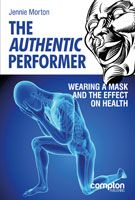NOTE: This title is now published by the author. Orders should be directed to her at info@healthyperformers.com
The Authentic Performer
Wearing a Mask and the Effect on Health
Jennie Morton
This book is written from the author’s own perspectives as Theater performer, actress and professional singer from the age of two years old and, latterly, as an Osteopath specializing in the treatment of performing artists. Blending this experience and expertise, Jennie Morton uniquely draws together the physiological, psychological and sociocultural aspects of being a performer, and views them in the context of health and well-being.
Illuminated with interviews with leading performers from many disciplines, including Paul Roberts, lead singer of The Stranglers, and Stefan Dennis, actor and cast member of Australian television series, Neighbours, the book provides detailed information on the physiological processes behind performing arts related injuries giving the reader the information to better manage their own health.
Crucially, the author examines the culture of training in the performing arts and how best to prepare student performers for life in the profession. This issue is particularly pertinent to the author, who posits that the ‘wearing of a mask’ is inherent in many performers and is sometimes seen to be a prerequisite of many performing arts professions. It is this ‘hiding behind the mask’ that is a centerpiece of the work here, as Morton explains that ‘in my experience as an Osteopath treating performers, the further removed they are from their authentic selves and the more buried they are beneath their own masks, the longer they seem to take to heal. I wanted to explore this connection further and have therefore delved into the medical, psychological and philosophical literature to discover the underlying physiological and biological mechanisms at play. I have then placed these in the context of the cultural requirements of being a performer in the modern world to see how we can explain the issues with which so many performing artists struggle’.
The book explores how early childhood experiences can influence both emotional and physiological development and how this can play a role in the creation of talent and artistry. It looks at the culture of negative/fear-based training in the arts and how this can lead to the issues of perfectionism and obsession so often associated with performing artists. The neurology of creativity is also discussed along with issues of mental health with historical and cultural references to performers throughout history. The historical roots of art itself are also discussed with a look at how body language and early communication developed into the music and art of today. Issues of art as a commodity in the modern world are examined and how these can affect the health and psychological well-being of artists who try to earn their living from their passion. The physiological mechanisms that lead to the pain and anxiety often experienced by performing artists are explored, and descriptions of muscle injuries and inflammatory processes are given to inform the reader so they can better understand their own body mechanisms and how to manage them. The sympathetic nervous system, or ‘fight or flight’ mechanism is also discussed with reference to performance anxiety and pain levels. The neurology of finding the performance ‘zone’ is another subject of discussion.
If this sounds like a science or sci-fi book – it isn’t! It reads beautifully, and is perfectly pitched for the performer and student performer, as well as those who work with and support them. Much of the Performing Arts Medicine research and literature from the medical, psychological and philosophical domains has not filtered down to those performers who could benefit from it; this book simplifies and contextualizes that research into a concise, readable and wholly practical resource.
